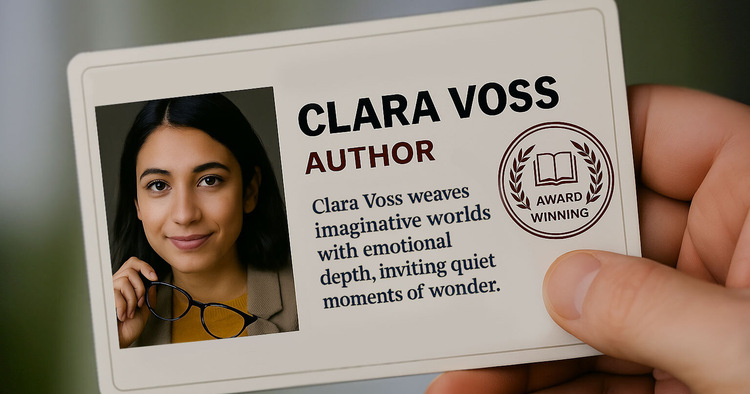You never get a second chance to make a first impression; for authors, your bio is often that first “hello.” Before someone even reads a line of your story, they might glance at your author bio to see who’s behind the book. It’s a small space that carries a lot of weight, especially if you’re hoping to connect with readers, land interviews, or build your credibility.
So, how do you make sure it sounds like you, and actually makes people want to read more? That’s what we’re here to help with. From key ingredients to real examples, we’ll walk you through how to write an author bio that goes beyond the basics.

What Is an Author Bio?
The author biography, or bio for short, is a concise paragraph that introduces you to the readers of your book. It’s usually found at the back of a book, on an online product page, or on the author’s website. It gives people a quick idea of who you are, what you write, and why they should take an interest in your work.
Additionally, if you’re planning to work with an agent, you’ll be asked to include a short bio in your query letter. Wherever it appears, your author bio plays a small but important role in building your presence as a writer.
Why Is Your Author Bio So Important?
Unless you’re already a well-known author, readers might not be familiar with who you are or what you’ve written. That’s why writing a brief bio can help introduce you to your audience and set expectations for your work. Plus, your bio can come with other benefits as well, such as:How to Write a Book Dedication that Readers Will Remember
- Boosting your credibility as an author: Whether you’re listing relevant credentials or sharing your professional experiences, your author bio reassures readers that you know what you are talking about. This is especially important for non-fiction books.
- Helping you establish a connection with the readers: Your author bio is a great place to add a call-to-action, such as a link for your readers to visit your website. This can encourage them to join your community and keep up with your work.
- Familiarizing readers with your brand: Your author bio acts like a snapshot of your writing identity. It’s often the first impression readers get of you as an author. So, getting it right can help showcase your author brand.
Types of Author Biographies
Depending on where you’ll use your author bio, you might need to write different versions. The main distinction usually comes down to its length as well as the information you choose to include. With that in mind, let’s go over the three main types of biographies you might need as an author:
- Social media bios: These bios appear on your social media pages. They tend to be quite short due to character limits; for example, Instagram only gives you 150 characters to use in your bio. So keep it fun and to the point. Feel free to be a little more playful or personal here.
- “About the Author” section: This is the one you’ll typically find at the back of a book, in its metadata, or on a product page. It’s usually around 50 to 100 words and gives a quick overview of who you are as a writer. This is also the version you’ll use across most publishing platforms.
- Query letter bio: When querying an agent, you’ll want a much shorter bio, just one to three sentences. It should focus on your writing credentials and why you’re the right person to tell your story. Keep it professional, but let your personality peek through if it feels right.

Photo from Freepik
How to Write an Author Bio
Introducing yourself as a writer can be a challenge, even if you’ve published dozens of titles. You need to figure out not just what to write in it, but also how you’re going to phrase it. For example, should you use a unique writing style, or simply state the facts? To help you with all of that, we’ve summarized the process for you below:
- Write in the third person:
Author bios are typically written in the third person, especially for books and their product pages. You can only write in the first person if you’re adding the bio to your own platforms, such as your website, where a more personal tone would fit better.
- Mention your name, education (if relevant), achievements, awards, and genre:
The stronger your credentials, the more credibility you gain as an author. These credentials can include your publications, relevant education, or any awards you won or were shortlisted for. But what if you’re still starting out? In that case, you can just mention certain qualities about your writing or what makes your work unique. The more you write and share your work, the more those shiny achievements will come with time!
Example: “Sarah Lin writes science-backed wellness books and is a certified holistic nutritionist.”
- Mention a few personal facts to connect with readers:
For instance, mentioning a fun hobby, a quirky writing habit, or even a pet’s name can make you more interesting and relatable to your readers. Just don’t dwell on these details for too long and avoid adding too many of them.
Example: “He loves plot twists, strong coffee, and pretending to know how to cook.”
- Let your personality shine through in your bio:
Adding a touch of personality to your bio can go a long way towards familiarizing readers with yourself and your author brand. After all, when introducing yourself to your audience, you should leave a lasting impression!
Example: “She lives in a secret cave with her rugged resistance fighter husband and pet tiger.”

Photo from Freepik
- Only write about what you’re comfortable sharing with the public:
Not everyone wants to share their real name, exact location, or family situation, and that’s okay. You can use a pen name or mention only the region you live in, for example. Just keep in mind that your author bio helps shape the image of yourself that you present to your audience. So, try to make that image as close to the real thing as you’re comfortable with.
- Match the tone of your bio to your book:
The style of your bio should reflect the kind of writing you do. For instance, a playful or sarcastic tone might work well for a romantic comedy, but it could feel out of place in a serious self-help or spiritual book. Instead, you might mention something more fitting, like your passion for mindfulness or personal growth.
- Keep it short and relevant to the genre and audience you’re addressing:
As mentioned earlier, the length of your author bio depends on where it will appear. A short, punchy version works best for social media or query letters, while a longer version is better suited for the back of a book or your website. No matter the length, make sure your writing style is clear and appropriate for your audience. For example, if you’re writing for children, avoid complex language or technical jargon that might feel out of place.
- Add a call-to-action to keep readers connected:
If you’d like your readers to stick around after finishing your book, include a short line inviting them to take the next step. That could be visiting your website, following you on social media, or signing up for your newsletter. A simple call-to-action can go a long way in building your audience and keeping them engaged with your work.
- Proofread it to catch any mistakes and/or language errors:
As with the rest of your work, your bio should be free of any grammar and spelling mistakes. After all, you’re aiming to establish your credibility as an author, which means solid writing is a must.

Photo from Freepik
Examples of Great Author Bios
Even with all the advice you can find, it might still be hard to convey what you want to share in your author bio. In that case, it can be quite helpful to look at real-world examples from published authors. Whether you’re new to publishing or have been doing it for years, the following examples may offer inspiration and ideas for crafting your own.
1. Adam Silvera
Adam Silvera’s author bio strikes a great balance between credibility and personality. It lists his bestselling status and numerous publications, which demonstrates his success and experience. He ends with a playful personal touch and includes a call-to-action directing readers to his website. All in all, this is a classic bio style for a well-known author, blending professionalism with a memorable voice.
“ADAM SILVERA is the #1 New York Times and USA Today bestselling author of They Both Die at the End, The First to Die at the End, The Survivor Wants to Die at the End, More Happy Than Not, History Is All You Left Me, the Infinity Cycle (Infinity Son, Infinity Reaper, Infinity Kings), and co-author of What If It’s Us and Here’s to Us. He is tall for no reason. Visit him online at adamsilvera.com.”
2. Gillian Flynn
Gillian Flynn’s bio is a solid blend of achievements, publications, and general facts about her. She mentions some of her most successful works as well as her past experience as a critic. At the end, she talks briefly about her family. Generally speaking, you can’t go wrong with a bio like hers.
“GILLIAN FLYNN is the author of the #1 New York Times bestseller Gone Girl, for which she wrote the Golden Globe–nominated screenplay; the New York Times bestsellers Dark Places and Sharp Objects; and a novella, The Grownup. A former critic for Entertainment Weekly, she lives in Chicago with her husband and children.”
3. Andy Weir
In contrast to the first two examples, Andy Weir’s bio is less focused on his publications and more on his interests and dreams. He mentions his interest in astronomy and physics as well as his past career as a software engineer. If you haven’t published any books yet, your bio can look similar to this one.
“ANDY WEIR built a two-decade career as a software engineer until the success of his first published novel, The Martian, allowed him to live out his dream of writing full-time. He is a lifelong space nerd and a devoted hobbyist of such subjects as relativistic physics, orbital mechanics, and the history of manned spaceflight. He also mixes a mean cocktail. He lives in California.”
4. Alice B. Sullivan
Alice B. Sullivan’s bio focuses on her favorite subgenre: apocalyptic fiction. She talks about her interest in the genre growing up, then mentions that her writing centers around possible scenarios for the end of the world. This bio suits the tone of her writing and can be a great example to follow for new authors, in particular.
“ALICE B. SULLIVAN was born and raised in a quiet town in upstate New York, where she spent way too much time pondering zombie apocalypse scenarios. When she isn’t chasing things that go bump in the night, Alice is writing about different ways the world could end.”
5. Chuck Wendig
Chuck Wendig mentions all kinds of work in his bio that goes beyond his published books. He also mentions his experience with comics, games, and film, as well as being a finalist for the Astounding Award for Best New Writer. After that, he goes on to mention his agent, his popular writing blog, and a glimpse into his private life. This bio is full of achievements, even if they’re not all listed out by name.
“CHUCK WENDIG is the New York Times bestselling author of Wanderers, The Book of Accidents, Wayward, Black River Orchard, and more than two dozen other books for adults and young adults. A finalist for the Astounding Award and an alumnus of the Sundance Screenwriters Lab, he has also written for comics, games, film, and television. He’s known for his popular blog, terribleminds, and books about writing such as Damn Fine Story. He lives in Bucks County, Pennsylvania, with his family. His agent is Stacia Decker, with Dunow, Carlson and Lerner.”

Photo from Freepik
Final Thoughts
No two authors are exactly alike, which means your bio should reflect what makes you unique. Whether you’re highlighting your accomplishments or sharing a fun detail about yourself, your bio is an important part of your writing identity.
Just remember that clarity, tone, and relevance go a long way. Keep it short, make it true to your voice, and don’t be afraid to update it as you grow. And if you ever need a quick reminder, feel free to bookmark this article and come back to it anytime.
Have a favorite author bio we didn’t include? Share it with us in the comments!
.
Read More
How to Write a Book Dedication that Readers Will Remember
5 Simple Book Marketing Strategies That Actually Work (With 35+ Applicable Ideas)
How to Write a Synopsis for a Book: A Quick Guide (+ Examples)

